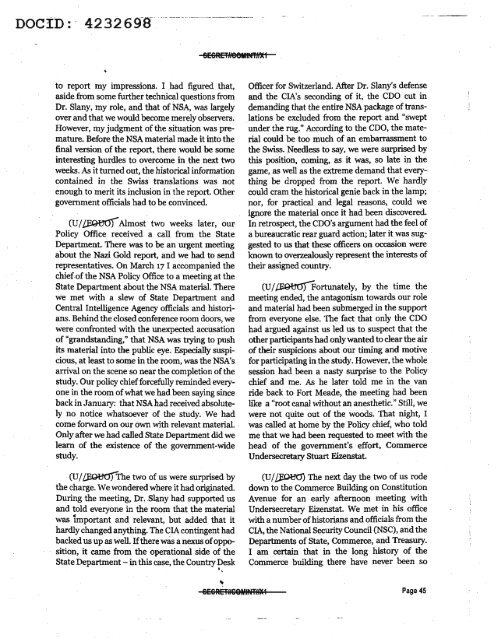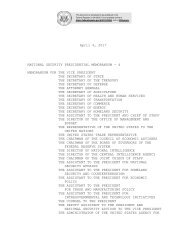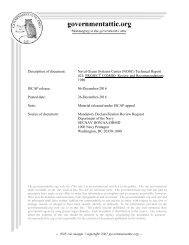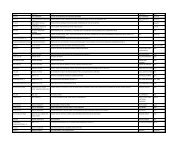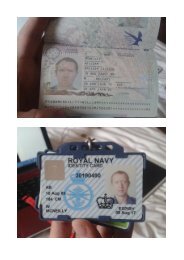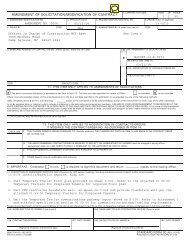government undersecretary
nsa-nazi-gold
nsa-nazi-gold
Create successful ePaper yourself
Turn your PDF publications into a flip-book with our unique Google optimized e-Paper software.
noc:tn: · 4232 69-a· --·----- ---------·-- ·---....<br />
SE6RElH88MINll¥~1<br />
to report my impressions. I had figured that,<br />
aside from some further technical questions from<br />
Dr. Slany, my role, and that of NSA, was largely<br />
over and that we would become merely observers.<br />
However, my judgment of the situation was premature.<br />
Before the NSA material made it into the<br />
final version of the report, there would be some<br />
interesting hurdles to overcome in the next two<br />
weeks. As it turned out, the historical information<br />
contained in the Swiss translations was not<br />
enough to merit its inclusion in the report. Other<br />
<strong>government</strong> officials had to be convinced.<br />
(U I f]iJdtJ(5) Almost two weeks later, our .<br />
Policy Office received a call from the State<br />
Department. There was to be an urgent meeting<br />
about the Nazi Gold report, and we had to send<br />
representatives. On March 17 I accompanied the<br />
chiefofthe NSA Policy Office to a meeting at the<br />
State Department about the NSA material. There<br />
we met with a slew of State Department and<br />
Central Intelligence Agency officials and historians.<br />
Behind the closed conference room doors, we<br />
were confronted with the unexpected accusation<br />
of "grandstanding," that NSA was trying to push<br />
its material into the public eye. Especially suspicious,<br />
at least to some in the room, was the NSA's<br />
arrival on the scene so near the completion of the<br />
study. Our policy chief forcefully reminded everyone<br />
in the room of what we had been saying since<br />
back in January: that NSA had received absolutely<br />
no notice whatsoever of the study. We had<br />
come forward on our own with relevant material . .<br />
Only after we had called State Department did we<br />
learn of the existence of the <strong>government</strong>-wide<br />
study.<br />
· (U I f]iJdtJ(5)The two of us were surprised by<br />
the charge. We wondered where it had originated.<br />
During the meeting, Dr. Slany had supported us<br />
and told everyone in the room that the material<br />
was 1mportant and relevant, but added that it<br />
hardly changed anything. The CIA contingent had<br />
backed us up as well. If there was a nexus of opposition,<br />
it came from the operational side of the<br />
State Department - in this case, the Country Desk<br />
•<br />
Officer for Switzerland. After Dr. Slany's defense<br />
and the CIA's seconding of it, the CDO cut in<br />
demanding that the entire NSA package of translations<br />
be excluded from the report and "swept<br />
under the rug." According to the CDO, the material<br />
could be too much of an embarrassment to<br />
the Swiss. Needless to say, we were surprised by<br />
this position, coming, as it was, so late in the<br />
game, as well as the extreme demand that everything<br />
be dropped from the report. We hardly<br />
could cram the historical genie back in the lamp;<br />
nor, for practical and legal reasons, could we<br />
ignore the material once it had been· discovered.<br />
In retrospect, the CDO's argument had the feel of<br />
a bureaucratic rear guard action; later it was suggested<br />
to us that these officers on occasion were<br />
known to overzealously represent the interests of<br />
their assigned country.<br />
(UI~ortunately, by the time the<br />
meeting ended, the antagonism towards our role<br />
and material had been submerged in the support<br />
from everyone else. The fact that only the CDO<br />
had argued against us led us to suspect that the<br />
other participants had only wanted to clear the air<br />
of their suspicions about our timing and motive _<br />
for participating in the study. However, the whole<br />
session had been a nasty surprise to the Policy<br />
chief and me. As he later told me in the van<br />
ride back to Fort Meade, the meeting had been<br />
like a "root canal without an anesthetic." Still, we<br />
were not quite out of the woods. That night, I<br />
was called at home by the Policy chief, who told<br />
me that we had been requested to meet with the<br />
head of the <strong>government</strong>'s effort, Commerce<br />
Undersecretary Stuart Eizenstat.<br />
(U I~ The next day the two of us rode<br />
down to the Commerce Building on Constitution<br />
Avenue for an early afternoon meeting with<br />
Undersecretary Eizenstat. We met in his office<br />
with a number of historians and officials from the<br />
CIA, the National Security Council (NSC), and the<br />
Departments of State, Commerce, and Treasury.<br />
I am certain that in the long history of the<br />
Commerce building there have never been so<br />
\<br />
SE6AET


